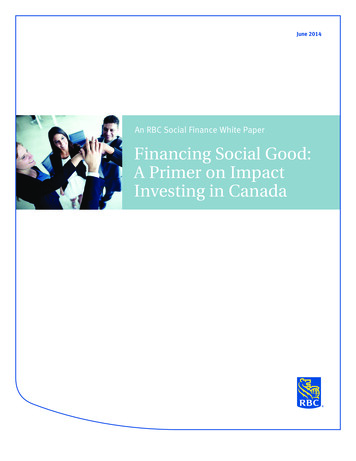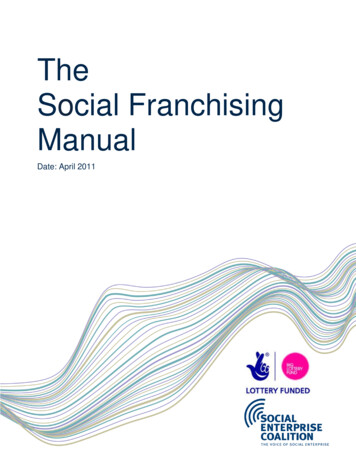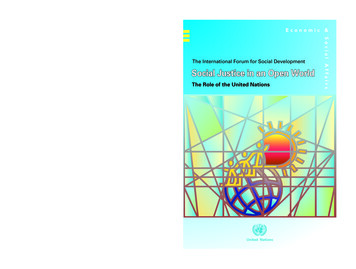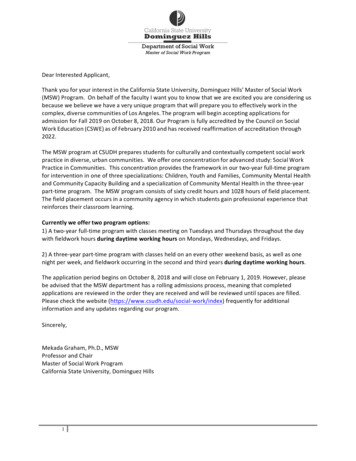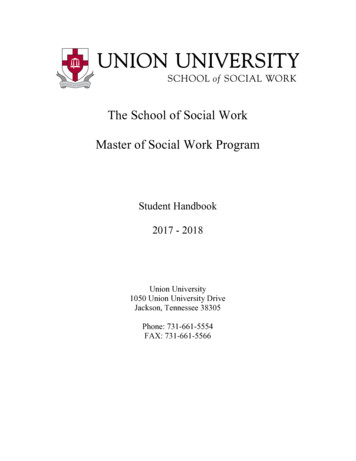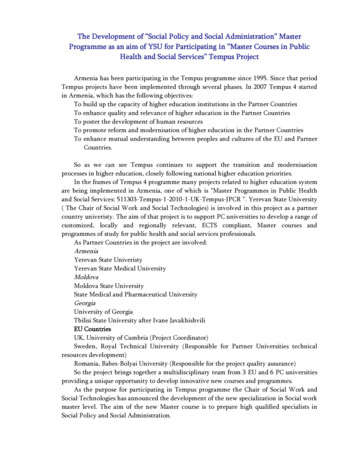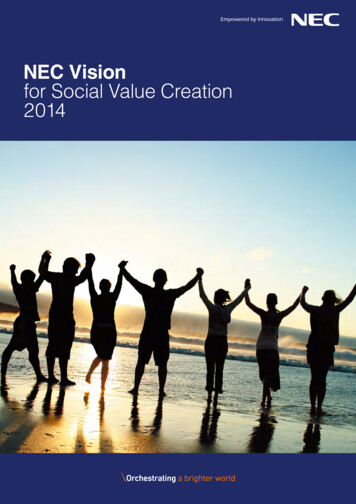
Transcription
NEC Visionfor Social Value Creation2014
In 2007, NEC formulated its “Group Vision 2017”These technological capabilities and know-howEarth” aiming to live in harmony with the Earth, (2)and set out to become “a leading global companygreatly contribute to the enhancement of social“Safer Cities & Public Services” for creating saferleveraging the power of innovation to realize aninfrastructure. Making full use of ICT, NEC aims toand more secure cities and their administrativeinformation society friendly to humans and theorganically combine individual infrastructures andfoundations, (3) safe and highly efficient “LifelineEarth.” Under the three-year “Mid-termcreate new value together with customers in aInfrastructure,” (4) “Communication” to support aManagement Plan 2015” that started in 2013, wevariety of fields, including transportation, powervibrant society, (5) “Industry Eco-System” to newlyaim to make global-scale contributions by solvingand energy, water and food, finance and healthcombine ICT with industries, (6) “Work Style” tovarious social issues focusing on “solutions forcare services. These efforts are aimed atoffer diversified and borderless work styles, and (7)society” that enhance social infrastructure bycontributing to the realization of a society where“Quality of Life” realized in an enriched, equal andmeans of ICT (Information and Communicationssafe and secure services are provided to peopleactive society.Technology).efficiently and equally.As a social value innovator, NEC is committed toMotivating NEC’s determination to focus on theRecently, NEC announced its new brand message,realizing “a brighter world” by collaborating closelyprovision of solutions for society is a variety of“Orchestrating a brighter world,” under which NECwith business partners and customers around thechallenges that the world economy and society willgroup companies will work as one entity toworld while taking full advantage of ICT.face in the future. If the world’s populationpromote the Solutions for Society Business. Thiscontinues to grow and concentrate into urbanmessage represents our firm determination thatareas, the current social infrastructure will noNEC will continue to exercise its leadership as alonger be able to support people’s daily lives. Incompany boasting unrivaled network andthis way, emerging social issues will require thatcomputing technologies, while integrating itssocial infrastructure be safer, more secure, moresuperior technologies, wealth of expertise andefficient and more equal in the future.ideas to orchestrate bright and hopeful lives and aUntil now, NEC has maintained its position as asociety of tomorrow together with people of thetechnology leader by driving the development ofworld.cutting-edge technologies in the areas ofIn addition, starting with the new brand messagecomputing and networks, both of which work as“Orchestrating a brighter world,” NEC formulatedthe base platforms for cloud computing andthe following seven themes to represent thisservices.approach of social value creation: (1) A “Sustainable2NEC Vision for Social Value Creation 2014November 2014President, NEC CorporationNobuhiro Endo3
NEC VisionFor Social Value CreationThis booklet features a clear formulation of our thoughts on how ICT (Information andCommunications Technology) can contribute to society, business and daily life inorder to achieve the goal of social value creation.NEC group is focusing its efforts on providing “solutions for society” by enhancingthe social infrastructure that utilizes ICT in order to ensure the safety, security,efficiency and equality of society and enable people to live abundant lives.Addressing various social issues poses a great challenge for us. At the same time, weconsider it a promising opportunity to rebuild social structures that achieve bothcustomer value and social value.With this booklet, we wish to convey two key messages.The first message is that as the world population grows and urbanization continues asit moves toward 2050, the demand for energy and food will keep outgrowing thepopulation. ICT serves as the key driving force for making full and efficient use of thelimited resources on the earth and establishing a new, sustainable and efficientinfrastructure that ensures people can live equally.The second is that NEC sets out our thinking on the process of social value creation: (1)identifying fundamental issues, (2) partnering for problem resolution, (3) utilizingbusiness models and assets in the ICT industry, and (4) satisfying both customervalue and social value. NEC has established a new corporate key message,“Orchestrating a brighter world” along with the seven themes to represent thisapproach of social value creation. Collaborating closely with customers and businesspartners, NEC is committed to achieve our goal as a social value innovator to makeworld a brighter place.We have also issued a separate booklet titled “NEC Vision: Case Studies andHighlights 2014” which features eight highlighted businesses of solutions for society.We sincerely hope it will prove to be useful to you.CONTENTSChapter 1 Mega Trend and Technology TrendFuture Trends of the World Economy and Society6 Megatrends and Their Complicated LinkageTechnology Evolution to Resolve Social IssuesChapter 2 NEC Vision for Social Value CreationCreation of Social Values through Problem ResolutionOrchestrate Smarter and Brighter Future with Seven ThemesChapter 3 Create the Future with CustomersSustainable Earth:Sustainable International Society Supported by ICTSafer Cities & Public Services:Safe and Secure Urban Foundation and Glocal Administrative ServicesLifeline Infrastructure:ICT Build Safe and High-Efficiency LifelinesCommunication:Advanced Information and Communications Systems Supports Enriched SocietyIndustry Eco-System:ICT Rebuilds Industrial Foundation from ScratchWork Style:Diversified New Work Style (cross-border and co-creation with robots)Quality of Life:Affluent Society Where Individuals Thrive and Equality of Treatment and Education4NEC Vision for Social Value Creation 20146681014141618182022242628305
Chapter1Mega trend and technology trendThe Earth in 2050Energy demandDemand for foodGreenhouse gas1.8 times 1.5 timesChapter1Mega Trend andTechnology TrendDemand for water1.7times 1.6 timesUrban population6.3 billion people1.8 times(currently 3.5 billion people)Global-scale change and technology innovation -- these two trends are the key drivers to shapethe future. In this section, the global trend, the technology trend and challenges we will face arediscussed.(Source: Data from OECD, FAO, PwC and the United Nations)Future Trends of the WorldEconomy and SocietyGrowth in urban population andresource consumptionAlthough accurately forecasting the future is noteasy, we still can anticipate big global trends andprepare for them.According to the United Nations, the world’spopulation of approximately 7 billion people as of2011 is expected to reach 8 billion people in 2025and increase to 9.6 billion in 2050. It is alsoanticipated that, as more people move into urbanareas, the world’s urban population will increasefrom 3.5 billion in 2011 to 6.3 billion in 2050. As aresult, the demand for food, water and energy willincrease 1.7 times, 1.6 times and 1.8 timesrespectively. Also, greenhouse gas emissions areexpected to increase up to 1.5 times. This meansthat if today’s urban lifestyle persists, in 2050 wewill need twice the resources that the whole Earthcan supply. Therefore, in order to build asustainable world, we have no other choice but toimprove resource productivity, modify socialstructure and lifestyle and reduce resourceconsumption.6NEC Vision for Social Value Creation 2014Growth in emerging countriesand maturity in advancedcountriesThe growth in the world’s population alsoaccelerates the economies of emerging countries.According to PricewaterhouseCoopers (PwC), thetotal GDP of the top 7 emerging countries (China,India, Brazil, Russia, Indonesia, Mexico and Turkey)has already reached 80% of the sum of the GDPsof the G7 nations (the United States, France, theUnited Kingdom, Germany, Japan, Italy, Canada)and it is expected to grow up to 175% in 2050, 1.75times that of the G7 national economies. If theeconomies of emerging countries continue to growat this pace, these countries and their surroundingcountries will see more urbanization with a greaternumber of middle-income households, which willform a massive cross-border economic sphere. Onthe other hand, in advanced countries, thepercentage of elderly people in the population isexpected to increase from 18% at present to 26%in 2050, which will inevitably result in the relativedecline of their economic clout. The worldeconomy is already shifting from the traditionalG7-centered or US-centered economic structure toa multi-pole economic framework involving theemerging countries. In the future, this trend will bespurred and decentralization of economic clout willbe further evident.Economic growth in emerging countries is alsodriving the global penetration of the Internet.The number of Internet users worldwide wasreported to be 2.74 billion in 2013 and is expectedto exceed 3 billion in 2014. And in 2025, it isexpected that 4.7 billion people, which account for60% of the anticipated 8 billion world population,will gain access to the Internet. The worldwidepopularization of the Internet will certainly narrowthe digital divide among countries and activate theborderless transmission and distribution ofinformation on a personal basis. Through theInternet, individuals will gain the power to gatherand transmit information and influence society aswell as corporations and organizations.New social infrastructurerequiredThe deconcentration of economic power resultingfrom economic growth in emerging countries andthe expanded influence of individuals enabled byInternet penetration will form a flat and open world.On the one hand, the flat and open world will bringabout desired effects such as acceleration ofglobal collaboration and progression of innovationon a global scale including “reverse innovation”, aninnovation that is born in and spread from emergingcountries that used to unilaterally importtechnologies from advanced countries. On theother hand, in the flat and open world, there couldbe increased risks of large-scale conflicts andcrimes arising from historically peaceful areas.The deconcentration and networking of the worldeconomy increase interdependencies among eachnational economy. The increased interdependencywill cause the impact of an incident such as aconflict, a cyberattack, or a natural disaster in acertain country to propagate to all countries andregions in the blink of an eye. This means that,while maintaining its economic growth, eachemerging country is required to implement safeand smart cities and social infrastructuredevelopment with a particular focus on enhancingmeasures against the steep increase in urbanpopulation and environmental burden. On the otherhand, each advanced country needs to maintain itsnational power. More specifically, each advancedcountry is required to take appropriate measuresto build “a mature society model” includingimprovement of the social security system to copewith increasing aging population, fulfillment ofmedical and nursing services and anti-agingmeasures for public infrastructure.Emerging countries presumably have differentsocial challenges and approaches to address thanthose of advanced countries. A “new socialinfrastructure” that takes into account suchdifferences, makes full and efficient use of thelimited resources on the earth and provides allpeople with brighter lives is now required.7
Chapter1Correlation of 6 megatrendsChanges in emerging and advanced countriesChanges in emerging countriesChanges in advanced countriesContinued urbanizationBuilding mature society model tosupport aging society· Expansion of middle-income group· Formation of cross-border mega-cities andeconomic spheres· Smart and disaster-resistant cities· Improvement of social security system· Fulfillment of medical and nursing services· Anti-aging measures for public infrastructureUrbanization ratio in the worldRatio of elderly population in advanced countries70%50%(current)18%(in 2050)(current)26%(in 2050)(Source: Data from the United Nations)Power deconcentrationChange in power balance between nationsInternet user population2 billion people (current)(current)Power deconcentration175%(in 2050)At global level advanced countries vsemerging countriesAt society level nation vs companies andorganizations vs individualsPromotion of innovation· International specialization· Reverse innovation4.7 billion people(in 2025)· Regional conflict· Crime (real and cyber)· Growing uncertainty(Source: Data from PwC and International Development Engineering Society)6 Megatrends and TheirComplicated LinkageGuiding compass toward thefuture in 10 yearsIf we thoroughly analyze the trends of the worldeconomy and society, we will see major trends forthe next 10 years. NEC classifies such huge trendsof changes and transformations into the following 6megatrends toward the year 2025: (1) progressionof resource and environmental issues, (2) growth inemerging countries and their new challenges, (3)search for mature society models, (4) increase inNEC Vision for Social Value Creation 20142Growth inemergingcountries andtheir newchallenges3Search formaturesocietymodelsMajor natural disastersDamage towater sourcesUneven distribution of waterBasic infrastructuredevelopmentMegacities and hugeeconomic areasPenetration of basicpublic servicesEducation and medical careReform of social securitysystemImprovement of nationalfinanceRebuilding socialinfrastructure and servicesFulfillment of medical,nursing and health cares4Borderless virtual worldCollapse of the conceptof “Country”Improvement in Internetenvironmentpower and influence of individuals, (5)deconcentration of power and (6) diversifiedthr
4 NEC Vision for Social Value Creation 2014 5. Growth in urban population and resource consumption Although accurately forecasting the future is not easy, we still can anticipate big global trends and prepare for them. According to the United Nations, the world’s population of approximately 7 billion people as of 2011 is expected to reach 8 billion people in 2025 and increase to 9.6 billion .





